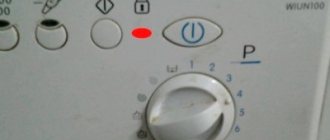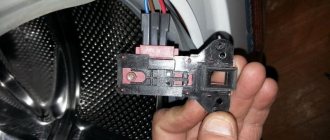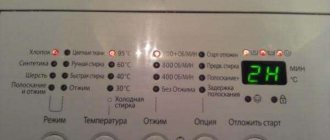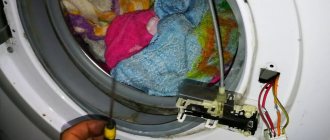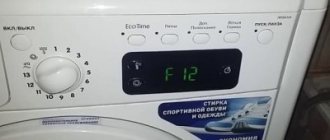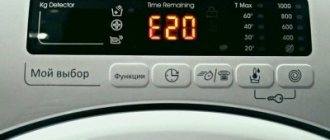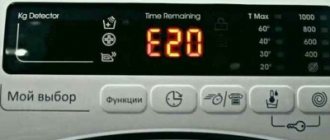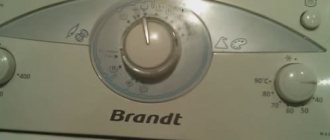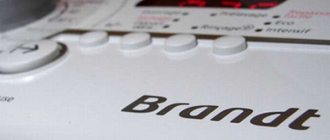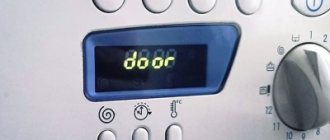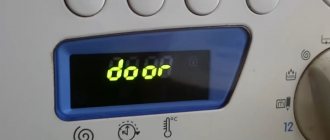Sometimes users are faced with the fact that the washing machine door does not lock, or, on the contrary, does not want to open after washing. In most cases, the culprit is the blocker. The lock may become clogged with dust, burn out, or simply stop working due to wear and tear. To fix the problem, you will have to delve into the UBL device of the washing machine. Understanding the principle of operation of the lock, knowing what parts it consists of, even a beginner will be able to diagnose the lock. Let's look into the nuances.
Device
Note that there are a large number of variations of locks. Manufacturers of washing machines install different locks on their models, which differ in shape, size, and method of fastening. They also differ in their operating principles. There are mainly two types used:
Thermal UBL
At the heart of the thermal lock is an RTS resistor and (or) a bimetallic plate. After closing the hatch and starting the washing program, a voltage of 220 volts is supplied to the resistor. It begins to heat up quickly and simultaneously heats the plate, which bends. As a result, it blocks the hatch hook using a latch, preventing it from opening during the wash cycle. The bimetallic plate also closes the control contact, as a result of which the selected program begins to be executed.
The diagram and principle of operation of such a lock is shown in the figure below.
Note that markings in the form of letters: N, L and C are often present on the UBL contacts, which makes it easier to check. Instead of an RTS thermistor, a winding made of high-resistance wire can be used. And also two resistors are used in some models, which does not change the principle of operation.
Let us repeat that locks vary in shape, size and fastening, and if you need to purchase them, you need to select them according to the product number of the machine.
This type of lock opens itself after the wash is completed. This is both a plus and a minus. The main disadvantage is that the opening takes place after 2-3 minutes, since the bimetallic plate needs time to cool and take its original shape, thereby releasing the tongue that holds the door. Most washing machines have a light indicator for holding the hatch.
I work in the household appliance repair industry. Extensive experience in restoring washing machines and dishwashers.
Such UBLs are used in inexpensive models Indesit, Ariston, Beko, LG, Samsung, Ardo, Whirlpool "(Whirlpool).
Electronic lock
An electromagnet is added to such a locking device, which is controlled by pulses coming from the module. And also in such UBLs there may also be an RTS resistor. In this case, the thermistor with a bimetallic plate closes the control wire, and the electromagnet moves the latch that blocks the hatch. The castle is shown schematically in the figure below.
Sometimes such a UBL is called instantaneous, because locking and unlocking occur instantly. This is an undeniable advantage.
Such devices are installed on models of the mid-price level and above, such as: Electrolux, Zanussi, Candy, Bosch, Siemens, "AEG" (AEG). There is only one drawback: the verification is difficult. A hatch with such a UBL can be opened only if the following conditions are met:
- the machine is connected to the electrical network;
- none of the programs are running;
- there is no water in the drum;
- The engine does not rotate.
Note that washing machines with such locks are equipped with emergency opening devices, which are usually located in the area of the drain pump filter cover.
How does it work
The function of the sensor responsible for closing the hatch is to prevent the lock from disengaging before the program ends.
Basic design of the lock
As soon as the hatch of a working Samsung, LG or other company washing machine is closed and the washing program has been entered, the following processes occur:
- The control current passes through the thermistor, and it expands, heating up.
- The thermistor pushes the bimetallic plate, it bends and presses on the pin.
- The pin fits into the groove of the lock and secures the hatch hook.
The washing machine door sensor is energized the entire time the program is running. When it turns off, the thermistor cools down and the plate releases the hook.
Examination
At home, you can only fully check the thermal UBL. To do this you need a Multimeter
(from the English multimeter),
tester
(from the English test - test),
avometer
(from the ampere-voltmeter) - a combined electrical measuring device that combines several functions.
The minimum set includes the functions of a voltmeter, ammeter and ohmmeter. Sometimes a multimeter is made in the form of a clamp meter. There are digital and analog multimeters.
"> multimeter, screwdriver (slotted or Torx - a type of slot of threaded fasteners in the shape of a six-pointed star. Registered trademark of Textron Fastening Systems (now Acument Global Technologies). The official name recorded in the ISO 10664 standard is hexalobular internal, in the Russian version GOST R ISO 10664-2007 - star-shaped recess for bolts and screws
.
Everyday names are star, asterisk, torx .
">torx) and an electrical extension cord.
First, pull the device out of the case. To do this, remove the collar from the cuff and pull back the edge next to the lock. Then unscrew the two screws that secure the lock to the body and pull it out. We pull off the chip. UBL is ready for diagnostics.
I work in the household appliance repair industry. Extensive experience in restoring washing machines and dishwashers.
Standard marking of thermal lock: N,L,C. A resistor passes through N and L. There is a certain resistance at these contacts. The remaining couples are broken up. If the contacts are numbered differently, you can tell by the resistance.
Another option is to connect the light bulb alternately to the terminal contacts, turn on the CMA and run the program. On the contacts that go to the resistor, the light will light up brightly.
To diagnose, we perform the following steps step by step:
- We supply 220 volts to contacts N and L using an extension cord.
- Use a screwdriver to move the moving part of the lock until it clicks. The latch should pop out. Thus, simulating the closing of the door. If there is no click and the moving part does not lock, then the lock is faulty and must be replaced.
- After 30-60 seconds, disconnect the UBL from the electricity.
- Using a multimeter, we measure the resistance between terminals C and L. It should be equal to 0. This means that the device is working. If it is broken, it needs replacement.
So, if point 2 did not work - there was no click and the moving part did not lock, then this means that one of the functions does not work and the lock is faulty. You don’t have to carry out further checking and buy a new UBL.
If, when performing step 4, the tester showed a broken connection, this means that another function of the lock does not work and replacement is necessary.
You should not experiment with trying to restore the device’s functionality. Thermal blockers cost 300-900 rubles, depending on the brand, model and greed of the parts supplier.
Buying a used lock is a very controversial decision. This will lead to a recurrence of problems; in addition, you need to understand that a burnt, worn lock can lead to damage to the electronic module. And these are other expenses.
What causes breakdowns?
The washing machine door closing sensor usually breaks down for two reasons. Most often, the malfunction of the lock is caused by simple wear and tear of the mechanism parts due to long-term operation of the machine. So, over and over again, when heated, the plate deteriorates, and after a few years the fixation weakens to a minimum. If this is the case, repairing the lock will be impractical; it is better to remove the old one and install a new UBL.
In addition, problems with the electronics of the machine may cause a malfunction of the locking device. The issue may be that:
- voltage drops in the electrical network “break through” the thermal element of the lock, it stops heating and transferring charge to the plate and hook;
- The triac on the board, which is responsible for the operation of the blocker, closes, as a result of which current is constantly supplied to the UBL, so the door lock is not removed.
Replacing UBL
If the lock is faulty, it all comes down to replacement. Restoring functionality does not make sense, because all damage occurs due to overheating. You can carry out repairs yourself without involving a technician from a service center. To do this you will need: spline and Phillips (Phillips) - Cross-shaped self-ejecting. Type H according to GOST 10753-86 Cross-shaped slots for screws and screws. Dimensions and control methods."
Pozidriv (Pozidriv) - An improved version of the Phillips slot, non-self-ejecting. Type Z according to GOST 10753-86 Cross-shaped slots for screws and screws. Dimensions and control methods." Due to the large depth of the slot, it is used only where screws are forced to have large heads.
“>a Phillips screwdriver and a little skill.
Let's take a closer look at all the actions:
- We remove the clamp. As a rule, it is a circle made of wire and a steel spring. We find it with our hands and pry it off with a slotted screwdriver. We tighten the clamp.
- We pull off part of the cuff in the area where the lock is attached.
- Unscrew the two screws that secure the lock.
- We remove the UBL by hand into the space between the cuff and the body.
- We pull the chip.
- We install a new lock.
- We put it inside the car and fasten the screws.
- We put the cuff back on, carefully working with our fingers.
- Reinstall the clamp. Here you will need the help of another person, or a second screwdriver.
Be sure to check that the hatch is closed. It should click into place.
Replacement can only be done if the door opens. Because the mounting screws are covered by the hatch. And if it is closed, then the replacement will not be possible. We will consider what to do if the hatch is blocked in another material.
What does the closing module consist of?
Before disassembling the hatch locking device, it is worth understanding what it is, what parts the mechanism consists of, and how it works. Modern automatic machines are equipped with bimetallic locking locks. This module is very reliable - it will not allow the door to be opened during washing. So, the washing machine door lock includes:
- thermocouple;
- fixing “tongue”;
- bimetallic plate.
The operating principle of the door locking module is as follows:
- the control unit supplies current to the lock thermocouple;
- The thermoelement heats up in 1-3 seconds;
- the charge is transferred to the bimetallic strip;
- the plate changes in size and puts pressure on the latch;
- The “tongue” falls out and remains in a special recess.
A characteristic click will notify you that the door lock has been activated.
The hatch opens in the same way, only all steps are performed in reverse order. When the current supply is stopped, the bimetallic plate changes shape, the latch “comes out” of the groove and “falls” into place. The door lock is removed.
It should be understood that on most models of washing machines, the UBL operates only 1-3 minutes after the completion of the cycle. Therefore, you should not forcefully try to open the door right away. You need to wait until the plate cools down and the control module makes sure that there is definitely no water left in the tank.
If the hatch does not open even after 10-20 minutes, most likely the mechanism has malfunctioned. For what reason the blocker may break, how to check and repair it, we will tell you further. The locking device is located on the front wall of the housing, to the right of the drum door. Its location is revealed by a small rectangle that protrudes slightly outward. This is exactly the groove where the “tongue” of the lock fits.
A little about security
The principle of operation of UBL is a device for blocking the hatch of a washing machine.
There are mechanical and electronic devices.
“>UBL of the washing machine is based on the safety of users. Without locking the door, no program starts, water does not pour, and the drum does not rotate.
- SMA - automatic washing machine.
“>SMA must be grounded. The panel must have an RCD - Residual Current Device. This is a special mechanism to protect against electric shock. It reacts almost instantly (approximately 0.05 - 0.2 s) to a phase short circuit on the body, ground and to human touch. If a breakdown occurs, the voltage relay is reset to the housing and the contactor turns off the device, preventing electric current from passing.
“>UZO. It will allow you to detect possible current leaks.
- Do not lift the machine to a height, especially on a shelf. Over time, the shock absorbers wear out, and when spinning, the washer may move or even bounce.
- If you have small children, then buy an SMA - an automatic washing machine.
- If water appears, call a professional.
- If the inlet hose is not equipped with the Aquastop system, then after the end of the washing cycle, turn off the water supply valve.
“>SMA with child lock function, and activate it.
These simple tips will save your nerves and keep you and your loved ones safe.
The hatch locking device is an integral part of automatic washing machines. With their help, safe operation of the SMA is ensured - an automatic washing machine.
">SMA. If the lock breaks, the door will not lock and you will not be able to complete the laundry cycle. Understanding the operating principle will help you independently repair or replace the UBL - a washing machine hatch locking device.
There are mechanical and electronic devices.
Symptoms of a problem
The owner of a washing machine can determine if the lock is broken by the following signs:
- The equipment completed its work and turned off, but the hatch was still blocked. This indicates a malfunction of the UBL or central module.
- After selecting and turning on the mode, the door does not lock and the washing machine does not start executing the program.
- The washing machine displays a code or reports a UBL malfunction by flashing indicators in a certain sequence.
You can determine what the cause of the breakdown is using a multimeter.
Device
Note that there are a large number of variations of locks. Manufacturers of washing machines install different locks on their models, which differ in shape, size, and method of fastening. They also differ in their operating principles. There are mainly two types used:
Thermal UBL
At the heart of the thermal lock is an RTS resistor and (or) a bimetallic plate. After closing the hatch and starting the washing program, a voltage of 220 volts is supplied to the resistor. It begins to heat up quickly and simultaneously heats the plate, which bends. As a result, it blocks the hatch hook using a latch, preventing it from opening during the wash cycle. The bimetallic plate also closes the control contact, as a result of which the selected program begins to be executed.
The diagram and principle of operation of such a lock is shown in the figure below.
Note that markings in the form of letters: N, L and C are often present on the UBL contacts, which makes it easier to check. Instead of an RTS thermistor, a winding made of high-resistance wire can be used. And also two resistors are used in some models, which does not change the principle of operation.
Let us repeat that locks vary in shape, size and fastening, and if you need to purchase them, you need to select them according to the product number of the machine.
This type of lock opens itself after the wash is completed. This is both a plus and a minus. The main disadvantage is that the opening takes place after 2-3 minutes, since the bimetallic plate needs time to cool and take its original shape, thereby releasing the tongue that holds the door. Most washing machines have a light indicator for holding the hatch.
I work in the household appliance repair industry. Extensive experience in restoring washing machines and dishwashers.
Such UBLs are used in inexpensive models Indesit, Ariston, Beko, LG, Samsung, Ardo, Whirlpool "(Whirlpool).
Electronic lock
An electromagnet is added to such a locking device, which is controlled by pulses coming from the module. And also in such UBLs there may also be an RTS resistor. In this case, the thermistor with a bimetallic plate closes the control wire, and the electromagnet moves the latch that blocks the hatch. The castle is shown schematically in the figure below.
Sometimes such a UBL is called instantaneous, because locking and unlocking occur instantly. This is an undeniable advantage.
Such devices are installed on models of the mid-price level and above, such as: Electrolux, Zanussi, Candy, Bosch, Siemens, "AEG" (AEG). There is only one drawback: the verification is difficult. A hatch with such a UBL can be opened only if the following conditions are met:
- there is no water in the drum;
- The engine does not rotate.
Note that washing machines with such locks are equipped with emergency opening devices, which are usually located in the area of the drain pump filter cover.
Why do breakdowns happen?
The two main reasons for breakdowns of the door close sensor on washing machines are mechanical wear of the bimetallic plate and the loss of the thermal relay of its properties due to a sharp surge in voltage in the network (up). In both cases, the device requires repair and replacement of parts. The owner can check the properties of the relay using a household tester independently.
If the “lock” icon flashes on the machine’s dashboard, this does not always indicate a problem with the door locking. There are several similar situations:
- On some models of Atlant and Samsung machines, this may indicate a problem with the pressure switch and the correct water level in the drum.
- Sometimes Samsung cars give a flashing door indicator if there are problems with the heating element. In this case, the device requires qualified diagnostics and repair.
- On some models of LG washing machines equipped with a “child lock” function, the hatch lock is activated and released only by pressing certain buttons. Before calling a technician, you should check and rule out the “standard” closing of the hatch.
Thus, some breakdowns of the door close sensor can be corrected yourself.
Source
Examination
At home, you can only fully check the thermal UBL. To do this you need a Multimeter
(from the English multimeter),
tester
(from the English test - test),
avometer
(from the ampere-voltmeter) - a combined electrical measuring device that combines several functions.
The minimum set includes the functions of a voltmeter, ammeter and ohmmeter. Sometimes a multimeter is made in the form of a clamp meter. There are digital and analog multimeters.
"> multimeter, screwdriver (slotted or Torx - a type of slot of threaded fasteners in the shape of a six-pointed star. Registered trademark of Textron Fastening Systems (now Acument Global Technologies). The official name recorded in the ISO 10664 standard is hexalobular internal, in the Russian version GOST R ISO 10664-2007 - star-shaped recess for bolts and screws
.
Everyday names are star, asterisk, torx .
">torx) and an electrical extension cord.
First, pull the device out of the case. To do this, remove the collar from the cuff and pull back the edge next to the lock. Then unscrew the two screws that secure the lock to the body and pull it out. We pull off the chip. UBL is ready for diagnostics.
I work in the household appliance repair industry. Extensive experience in restoring washing machines and dishwashers.
Standard marking of thermal lock: N,L,C. A resistor passes through N and L. There is a certain resistance at these contacts. The remaining couples are broken up. If the contacts are numbered differently, you can tell by the resistance.
Another option is to connect the light bulb alternately to the terminal contacts, turn on the CMA and run the program. On the contacts that go to the resistor, the light will light up brightly.
To diagnose, we perform the following steps step by step:
- We supply 220 volts to contacts N and L using an extension cord.
- Use a screwdriver to move the moving part of the lock until it clicks. The latch should pop out. Thus, simulating the closing of the door. If there is no click and the moving part does not lock, then the lock is faulty and must be replaced.
- After 30-60 seconds, disconnect the UBL from the electricity.
- Using a multimeter, we measure the resistance between terminals C and L. It should be equal to 0. This means that the device is working. If it is broken, it needs replacement.
So, if point 2 did not work - there was no click and the moving part did not lock, then this means that one of the functions does not work and the lock is faulty. You don’t have to carry out further checking and buy a new UBL.
If, when performing step 4, the tester showed a broken connection, this means that another function of the lock does not work and replacement is necessary.
You should not experiment with trying to restore the device’s functionality. Thermal blockers cost 300-900 rubles, depending on the brand, model and greed of the parts supplier.
Buying a used lock is a very controversial decision. This will lead to a recurrence of problems; in addition, you need to understand that a burnt, worn lock can lead to damage to the electronic module. And these are other expenses.
How to test a part?
It is usually very easy to recognize that the door locking device is faulty. With such a problem, the washer clearly indicates a problem. Among the main “symptoms”:
- the hatch does not swing open, even after 1-2 hours have passed since the end of the wash;
- the corresponding error code is displayed on the display or the LED of the “Start/Pause” button on the “tidy” blinks 17 times (other indicators may also light up, this depends on the model of the washing machine);
- the door does not swing open even when the washing machine is disconnected from the electrical network;
- After starting the wash, the lock does not work and the machine does not start the cycle.
How to check if the door closing sensor of a washing machine is working? You can perform diagnostics using a multimeter. First, you should look at the instructions and study the electrical circuit of the washing machine. This will help to understand where the phase is located, as well as the neutral and common contacts of the UBL. Afterwards you can begin dismantling the blocker. You need to proceed as follows:
- turn off the power to the automatic machine;
- close the valve responsible for the water supply;
- disconnect equipment from communications;
- open the hatch;
- unscrew the bolts securing the UBL;
- Unscrew a pair of screws holding the top cover of the washing machine;
- push the panel towards you and remove;
- put your hand down, moving towards the blocker (it is located to the right of the cuff);
- unhook the wires connected to the lock;
- remove the device from the case.
Afterwards, you can “arm yourself” with a multimeter, switch it to resistance determination mode and lean the tester probes against the neutral contact and the lock phase. A three-digit number should appear on the display. If the value does not match, replace the UBL. At the next stage of testing, it is necessary to attach the wires to the common contact and phase. Using a screwdriver, you need to move the “tongue” of the lock into the working position and connect the device to the network. A working blocker will click, a broken one will remain silent.
If the diagnostics does not reveal any problems with the lock, inspect the hinges. They may be warped, causing the door to sag. Also, the reason for the machine’s reluctance to block the hatch may be mechanical damage to the “tongue” of the mechanism. Be sure to check this guess as well.
Replacing UBL
If the lock is faulty, it all comes down to replacement. Restoring functionality does not make sense, because all damage occurs due to overheating. You can carry out repairs yourself without involving a technician from a service center. To do this you will need: spline and Phillips (Phillips) - Cross-shaped self-ejecting. Type H according to GOST 10753-86 Cross-shaped slots for screws and screws. Dimensions and control methods."
Pozidriv (Pozidriv) - An improved version of the Phillips slot, non-self-ejecting. Type Z according to GOST 10753-86 Cross-shaped slots for screws and screws. Dimensions and control methods." Due to the large depth of the slot, it is used only where screws are forced to have large heads.
“>a Phillips screwdriver and a little skill.
Let's take a closer look at all the actions:
- We remove the clamp. As a rule, it is a circle made of wire and a steel spring. We find it with our hands and pry it off with a slotted screwdriver. We tighten the clamp.
- We pull off part of the cuff in the area where the lock is attached.
- Unscrew the two screws that secure the lock.
- We remove the UBL by hand into the space between the cuff and the body.
- We pull the chip.
- We install a new lock.
- We put it inside the car and fasten the screws.
- We put the cuff back on, carefully working with our fingers.
- Reinstall the clamp. Here you will need the help of another person, or a second screwdriver.
Be sure to check that the hatch is closed. It should click into place.
Replacement can only be done if the door opens. Because the mounting screws are covered by the hatch. And if it is closed, then the replacement will not be possible. We will consider what to do if the hatch is blocked in another material.
Diagnostics and repair of the lock on your own
To check the serviceability of the lock, it will need to be removed. Necessary:
- Unplug the washing machine.
- Open the hatch, bend the cuff, pry up the clamp and remove it.
- Pull the cuff to the side to gain access to the lock.
- Unscrew the fasteners securing the device.
- Disconnect the wiring and pull out the UBL.
This method is suitable if the door opens. Otherwise, you need to open the base panel on the front of the washing machine and find the emergency cable for opening the hatch. It is usually yellow or red and is located near the filter. If the cable is missing, you need to unscrew the fasteners holding the top cover, remove it, and then put your hand between the body and the tank, find the lock latch by touch and unlock it. Now you can open the door and begin removing the UBL.
Now you can start checking the blocker using a multimeter. To determine where the neutral and common contacts are located, you will need a diagram of the lock. Hatch locking devices are produced by various companies that arrange the contacts in their own way. Without knowing the diagram, it is impossible to understand the contacts and diagnose the lock. You can find the diagram on the Internet.
At home, you can only check the thermoelement that heats the plates. To do this you need:
- Set up the multimeter to measure resistance.
- Find the neutral and phase contacts and install probes on them.
- If a three-digit number appears on the tester display, this indicates that the blocker is working.
- Now you need to move the probes to the neutral and common contacts.
- If one or zero appears on the screen, the device is broken.
If the blocker is working properly, you need to inspect it for mechanical damage or manufacturing defects.
To replace, you need to purchase a new lock. This can be done at the manufacturer's service center, in a specialized store, or via the Internet. To avoid mistakes when purchasing a part, you need to tell the seller the make and model of the washing machine.
Installing the hatch lock is performed in the following order:
- Connect the wiring to the UBL.
- Place the lock inside the washing machine and insert it into the seat.
- Screw in the fastener.
- Return the cuff to its original place and install the clamp.
If after replacing the UBL the problems continue, this indicates a malfunction of the system board. It is not recommended to repair it yourself, because it can only worsen the situation. To diagnose and repair the breakdown, you should contact a service center or call a professional.
Some washing machine owners are interested in whether it is possible to bypass the lock and start washing. Theoretically, there is such a possibility, but in this case, everyone who has access to the technology will be at risk of electric shock. Also, if you open the unlocked door during washing, there is a risk of being scalded by hot water. It is for these reasons that it is recommended to carry out repairs and replace a part that is inexpensive, rather than searching for a way to bypass the blocking.
A little about security
The principle of operation of UBL is a device for blocking the hatch of a washing machine.
There are mechanical and electronic devices.
“>UBL of the washing machine is based on the safety of users. Without locking the door, no program starts, water does not pour, and the drum does not rotate.
- SMA - automatic washing machine.
“>SMA must be grounded. The panel must have an RCD - Residual Current Device. This is a special mechanism to protect against electric shock. It reacts almost instantly (approximately 0.05 - 0.2 s) to a phase short circuit on the body, ground and to human touch. If a breakdown occurs, the voltage relay is reset to the housing and the contactor turns off the device, preventing electric current from passing.
“>UZO. It will allow you to detect possible current leaks.
“>SMA with child lock function, and activate it.
These simple tips will save your nerves and keep you and your loved ones safe.
All front-loading machines are equipped with a lock. This device reliably closes the hatch door from accidental opening during washing. Imagine if in the middle of a cycle someone accidentally pulled the handle and a full tank of water spilled onto the floor. It is precisely these types of incidents that are prevented by protective blocking. But how to check the lock of a washing machine if it suddenly jams or, on the contrary, does not work? This will be discussed in the article.
All about the washing machine door closing sensor
The device responsible for the correct closing of the hatch and the tightness of the drum during the washing process is called UBL (hatch blocking device).
Hatch locking device
Its design includes a thermoelectric element and a bimetallic plate that physically block the door section in the washing machine body until the end of the wash. Knowing the design of the locking mechanism, you can detect signs of its imminent breakdown in time and replace the sensor without waiting for a more serious reason for repair. The design is similar for most automatic washing machines: LG, Atlant, Samsung, AEG.
Hatch locking device
When starting to check, it is important to understand what type of lock is installed in your model of automatic washing machine (WMA). In older SM releases, manufacturers installed blockers with an electromagnet. However, they were ineffective without electricity. If the electricity was turned off during washing, the hatch automatically unlocked.
Another thing is the hatch door lock based on bimetallic plates. They are used everywhere due to their efficient operation.
The structure consists of three main elements:
- thermoelement;
- bimetallic plate;
- fixing device.
How does UBL work? Everything is tied to electronics. The electronic board supplies current to the thermocouple, which heats up quickly. This, in turn, is applied to the plate, which, increasing in size, pushes out the latch. Typically, when you start a cycle, you will hear a click, which means the door is locked and ready to draw water.
Does the door open with a delay after the wash is finished? This is normal practice. This is how the safety system works by delaying the lock until the water has completely drained from the tank.
The principle of operation of the lock has been disassembled. Now let's talk about its problems: for what reasons does a breakdown occur?
Reasons for the malfunction of the lock in the washing machine
There are two main causes of breakdowns: physical wear and tear and electronic problems.
- Constant deformation of the plates when heated leads to damage and destruction of the element. In such cases, fixation does not work at all.
- Power surges in the network can lead to breakdown of the thermoelement. Then it does not heat up, therefore, the plate remains in place. The short circuit of the control triac results in the door not opening. Current is continuously supplied to the parts, so the latch does not turn off.
What should I do if there is a problem? Check the lock of the washing machine and replace it if it is faulty.
What to do if the lock of the machine is broken?
It is impossible to repair a worn-out part under any circumstances. The lock will have to be replaced with a new one. And if the door simply stops closing, this is quite easy to do, since getting to the lock itself will not be difficult for an experienced specialist. The craftsmen of our company cope with this task using one screwdriver. But, despite the ease of repair, we do not recommend that you change the device yourself if you do not have experience working with electronics. In order for the device to function correctly, you need to know how and how to connect the contacts.
The situation is much more complicated if the hatch door does not open. Then you will have to remove the entire front panel from the machine. And here you can’t do without an experienced repairman who knows how to handle washing machines. And you can find such people by contacting our company.
Our technicians will replace your device with a new, high-quality part from a trusted manufacturer right at your home. And your machine will serve you for a long time.
18-01-2017
Replacing the cuff of the washing machine hatch
A washing machine, like any equipment, depends on individual components, and often such parts have to be serviced or even replaced with other, newer ones.
Read more
18-01-2017
Why won't the washing machine start?
We have all ever encountered a situation where we urgently need to wash clothes, but the washing machine does not start. What to do? How to detect a breakdown? What types of faults are there? All this and more you can find on our website.
Read more
17-01-2017
Error E18 in a Bosch washing machine - what to do?
Eliminating error E18 in Bosch vertical and horizontal loading washing machines
Read more
15-01-2017
Repair of the control module of washing machines in Yekaterinburg
The most common causes of breakdowns of control modules of washing machines. How to recognize a malfunction? What should I do if the board fails, and what is the most cost-effective repair method?
Read more
14-01-2017
How to clean a washing machine filter
An article about proper cleaning of the filter in an automatic washing machine
Read more
08-01-2017
Why is the washing machine noisy?
A washing machine is a complex mechanism and for its smooth operation it is necessary to strictly follow the requirements of the operating manual and if the washing machine is noisy, then it is necessary to take urgent measures for inspection and repair.
Read more
Our advantages
- We provide free consultation on repair issues
. In the Question-Answer service you can ask any question regarding the choice of operation or repair of your machine. The specialist will respond within 2 days. Consultations by phone are carried out only on issues of possible breakdowns and the cost of repairs. To do this, you need to leave a repair request to the dispatcher, after which the technician will contact you and answer your questions. - We come and diagnose the equipment at the client’s home for free.
The invoice for the service includes only the work of the master and new parts (UBL or door lock components), if they are installed from the company’s stocks. - We repair at home within 24 hours after the application
. We are located next to you. Branches throughout Moscow and the region. The technicians work at addresses near the branches and arrive quickly. Upon request in the morning, repairs are carried out in the evening of the same day. If ordered in the evening, a specialist will arrive the next morning. Need repairs at another time? Choose a day and wait for the master at your convenience. We repair at the client’s home, we do not transport equipment to the workshop. - We work daily from 8 to 22.
Regular schedule - we repair every day: on weekdays, weekends and holidays. Choose early morning or late evening if you work to a strict schedule. The master will arrive when you have time. - We guarantee the quality of repairs.
The warranty period is 12 months. We are responsible for the installed UBL and for the work of the master. If the part is purchased by the customer, the warranty only covers installation (labor work).
